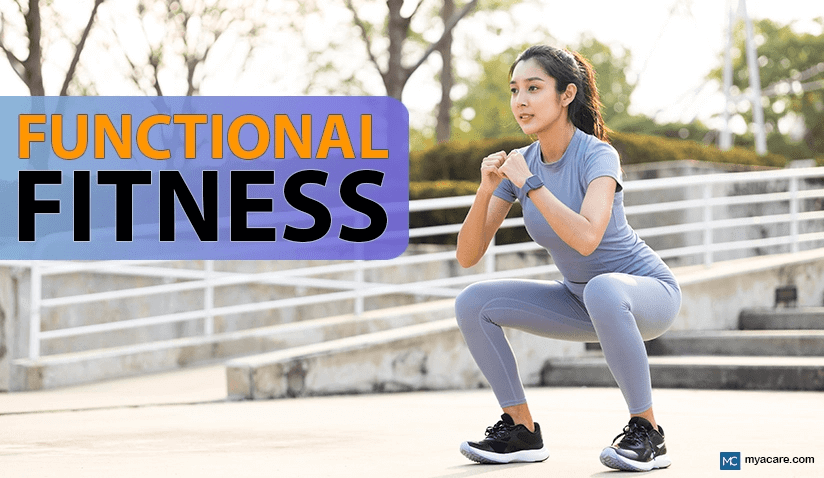Functional Fitness: What It Is and How to Train for It

Medically Reviewed by Dr. Rosmy Barrios - August 29, 2024
Functional fitness is a term that has become popular in recent years, especially among fitness enthusiasts and trainers. But what exactly does it mean, and how can you benefit from it?
In this article, we will explore the concept of functional fitness, how it differs from traditional strength training, and some examples of functional exercises and workouts that you could try.
What is Functional Fitness?
Functional fitness is a physical training approach that focuses on improving your ability to perform routine activities, such as lifting, carrying, bending, twisting, pushing, pulling, and balancing. Functional fitness exercises mimic these movements and challenge your muscles, joints, and nervous system to work together in a coordinated and efficient way.
It can be difficult to define what functional fitness is in a way that separates it from all types of exercise, as most forms of exercise will typically improve one’s overall functionality and ability to perform daily activities[1]. However, functional fitness emphasizes a unique approach by focusing on balance, strength, speed, flexibility, and power[2]. In this sense, functional fitness has been applied to multiple types of exercise, such as high-intensity functional training and functional strength training.
Functional vs Traditional Strength Training
Traditional strength training is a type of training that focuses on isolating specific muscle groups and increasing their size and power. Traditional strength training exercises typically involve using machines or free weights to perform repetitions of a single movement in a fixed range of motion. For example, a bicep curl is a traditional strength training exercise that targets the biceps muscle in the upper arm.
Functional fitness differs from traditional strength training in several ways:
- Multiple Muscle Coordination: Functional fitness exercises involve multiple muscle groups and joints working in unison to perform complex movements that require coordination, balance, stability, and agility. For instance, a squat is a functional fitness exercise that engages the muscles in the legs, hips, core, back, and shoulders.
- Adaptivity: Functional fitness exercises are more adaptable and variable than traditional strength training exercises, often using more body parts and muscle groups. For example, you can make a squat more challenging by adding weight, increasing speed, changing direction, or adding a jump. This can increase interest in performing these exercises as well as long-term adherence.
- Relevance: Functional fitness exercises are more relevant and transferable to real-life situations than traditional strength training exercises. Functional fitness exercises prepare you for the demands of your daily activities, hobbies, sports, or occupations. For example, if you enjoy hiking or skiing, functional fitness exercises can help you improve your endurance, stability, and power on uneven terrain.
Benefits of Functional Fitness
Like any form of exercise, functional fitness has many benefits for your health and well-being. However, unlike other types, functional fitness holds a higher degree of relevance to everyday activities and can be performed by people of most ages and fitness levels. Two reviews highlighted that even athletes and military personnel benefited from functional fitness training, which served to enhance their usual routine and physical activities. [3]
It can help one to more smoothly navigate physical challenges encountered in daily life, and also change and adapt in tandem with them. This has a higher relevance to aging than exercise routines that take an ordinary approach.
With this key difference in mind, the benefits[4] of functional fitness exercises include:
- Injury prevention: Functional fitness exercises strengthen your muscles, joints, and ligaments and improve your balance and coordination, which can help you avoid falls, sprains, strains, and other injuries.
- Posture: Functional fitness exercises correct your alignment and posture, which can help you reduce pain and stiffness in your neck, back, and shoulders.
- Mobility and flexibility: Functional fitness exercises increase your range of motion and flexibility, which can help you move more freely and comfortably in your daily activities.
- Tailored strength and endurance: Functional fitness exercises build muscle strength and endurance in a way specific to your hobbies, sports and occupations.
Over and above these benefits, functional fitness can also substantially contribute towards rounding out the metabolism similarly to ordinary exercise, improving immune function and lowering the risk of contracting chronic diseases.
Functional Fitness Exercise Examples
There are many types of functional fitness exercises that you can choose from depending on your goals, preferences, and available equipment. Most of them look similar to regular training, including lateral and normal lunges, glute bridges, squats, step-ups, pull-ups, push-ups and planks with variations, etc.[5]
Examples of functional fitness exercises that would make an ordinary fitness routine stand out include[6]:
- Deadlifts. simply bending down to lift weight off the ground until they are resting in the hands with the arms fully straightened at the sides, before placing them back on the ground again. Can be performed with dumbbells, a barbell or a kettlebell (with these, the legs ought to be spaced apart with the weight in front of you).
- Farmer’s walk. Hold dumbbells in both hands with the arms resting at full length on either side and simply walk in circles, holding them for as long as possible.
- Step-up to Shoulder Press. A variation of step-ups with dumbbells where one does a shoulder press when on the step. These involve lifting the dumbbell above the head on one side and then the other.
- Goblet squats. The same as a regular squat, except one clasps a weight to their chest while doing them.
- Dumbbell rows. Lean forward on one leg, lifting the other backward. Hold a dumbbell in each hand extended out before you towards the floor. Pull them up until your elbows are fully bent before sending them back to the same position in front of you. Repeat these in a steady “rowing” motion for as long as possible.
- Renegade rows. This involves getting on the floor with a dumbbell in each hand, in a high plank or push-up position. Pull each dumbbell up in a similar way to the dumbbell row, alternating sides to perform the “row.”
- Single-leg Romanian deadlifts. Starting in a standing position with arms stretched out fully at either side and a dumbbell in each hand, lean forward while lifting one foot back, allowing the dumbbells to guide the motion. To complete one repetition, lift yourself back up and bring your leg down. Alternate legs between sets or reps.
All of these exercises incorporate weightlifting in a natural way that builds muscles we would use to carry similar weights in real life. For example, these can be handy for effortlessly reaching down to pick up something heavy like luggage or a large bag of pet food without pulling a muscle or needing to catch your breath. If you don’t have weights for the above exercise, you might like to try doing some of them using actual heavy items you are required to lift every other day.
Functional Fitness Workouts
In line with the essence of functional fitness, a full-body functional workout is recommended for the best results.
A functional fitness workout is a sequence of functional fitness exercises that are performed for a certain amount of time or repetitions with minimal rest between them. It can be designed to target specific muscle groups and movements or to provide a full-body challenge. A functional fitness workout can be performed with or without equipment.
Here is an example of a full-body functional workout that you can try at home with little-to-no equipment:
Warm-up: Do some light cardio (such as jogging or skipping on the spot) for a couple of minutes and dynamic stretches (such as arm circles or leg swings) for 5-10 mins to prepare your body for the workout. It can be useful to stretch your legs, arms, lower back, neck and shoulders, as well as loosen your ankles, knees and wrists.
Circuit: Do each exercise for 30 seconds with 10 seconds rest between them. Repeat the circuit 3 times with 1 minute rest between each round.
- Lunges
- Squats
- Dumbbell rows (use other weighted objects if you don’t have dumbbells)
- Push-ups
- Planks
Cool-down: Do some static stretches (such as hamstring stretch or chest stretch) while breathing deeply for up to 10 minutes to relax your muscles and prevent soreness.
Conclusion
Functional fitness is a form of training that aims to improve your performance in everyday activities by enhancing your coordination, balance, stability, and agility. It differs from traditional strength training by involving multiple muscle groups and joints working synchronously in complex movements that are adaptable and relevant to real-life situations.
Functional fitness exercises and workouts can be performed with or without equipment and can be modified to suit different levels of difficulty, intensity, and specificity. Functional fitness can help you prevent injuries, improve posture, enhance mobility and flexibility, increase strength and endurance, and reduce your risk of chronic diseases. Try some functional fitness exercises and workouts today and see the difference for yourself.
To search for the best doctors and healthcare providers worldwide, please use the Mya Care search engine.
The Mya Care Editorial Team comprises medical doctors and qualified professionals with a background in healthcare, dedicated to delivering trustworthy, evidence-based health content.
Our team draws on authoritative sources, including systematic reviews published in top-tier medical journals, the latest academic and professional books by renowned experts, and official guidelines from authoritative global health organizations. This rigorous process ensures every article reflects current medical standards and is regularly updated to include the latest healthcare insights.

Dr. Rosmy Barrios is an aesthetic medicine specialist with international work experience. She earned her physician diploma at the Universidad Del Norte’s School of Medicine in Barranquilla, Colombia, and her specialty at John F. Kennedy University in Buenos Aires, Argentina. Dr. Barrios is a member of the Pan-American Aesthetic Medicine Association (PASAM) and the Union Internationale de Médecine Esthétique (UIME). She is an expert health writer with keen interests in aesthetic medicine, regenerative aesthetics, anti-aging, fitness, and nutrition. Currently, Dr. Barrios heads the Regenerative Aesthetics department at a renowned Internal Medicine clinic based in Belgrade, Serbia.
Sources:
Featured Blogs



